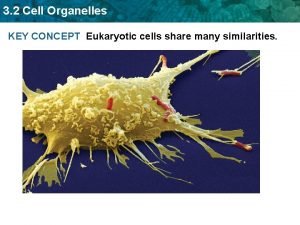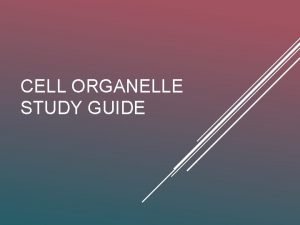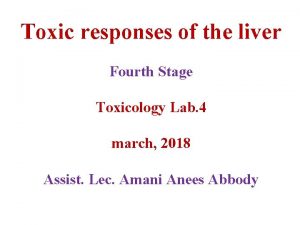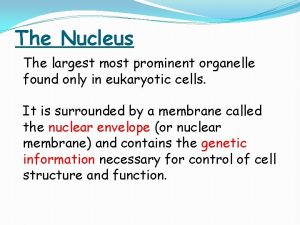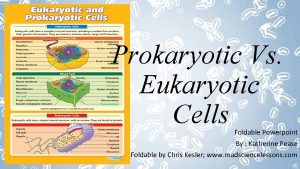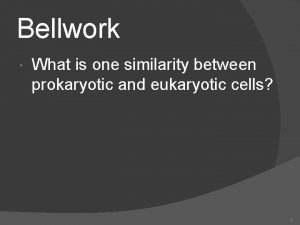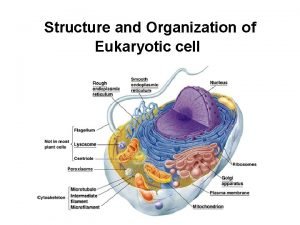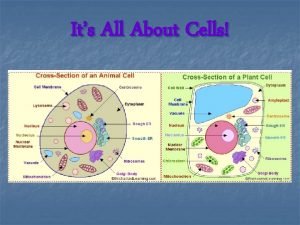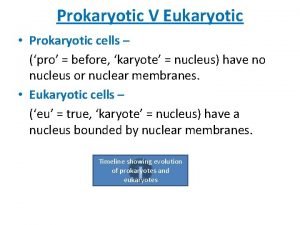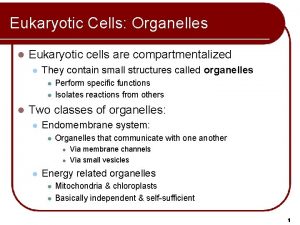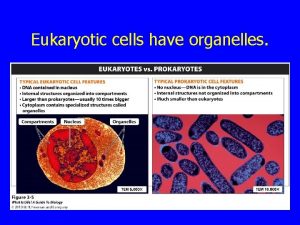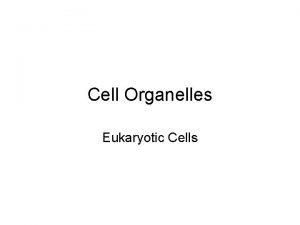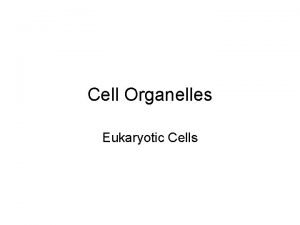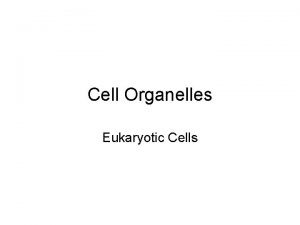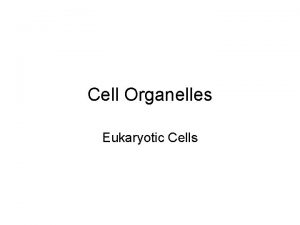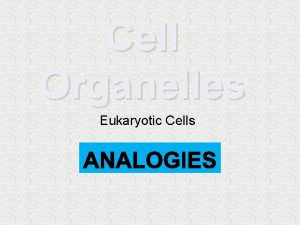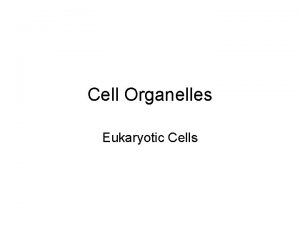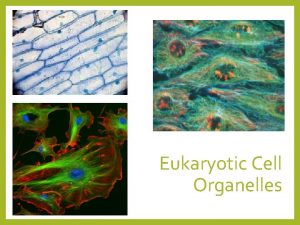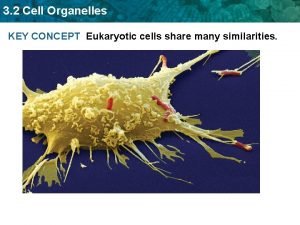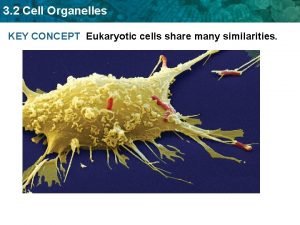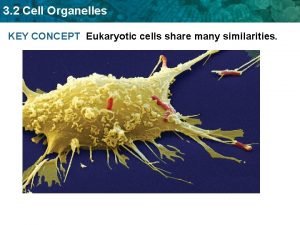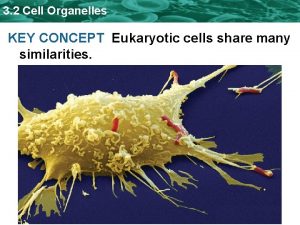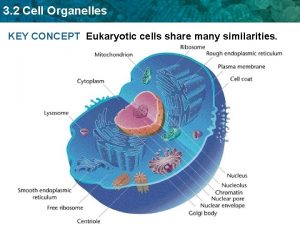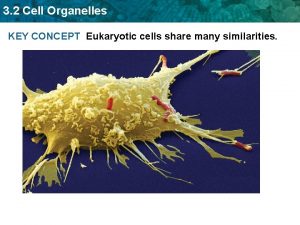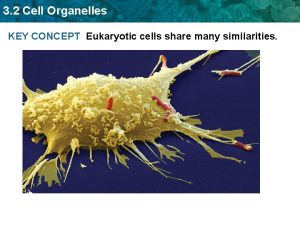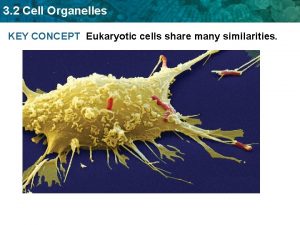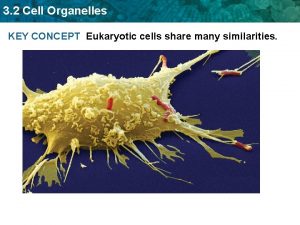3 2 Cell Organelles KEY CONCEPT Eukaryotic cells























- Slides: 23

3. 2 Cell Organelles KEY CONCEPT Eukaryotic cells share many similarities.

3. 2 Cell Organelles Cells have boundaries The Plasma Membrane • Forms a boundary between a cell and the outside environment • Controls the passage of materials into and out of the cell • Helps to maintain homeostasis

3. 2 Cell Organelles Cells have boundaries • The plasma membrane is selectively permeable - allows some, but not all materials to cross Outside the Cell Oxygen Wastes Invaders CO 2 Water Wastes Inside the Cell Glucose

3. 2 Cell Organelles Cells have boundaries Structure of the Plasma Membrane • Composed of a phospholipid bilayer

3. 2 Cell Organelles Cells have boundaries Other components in the Plasma Membrane Proteins • some span the entire membrane and help materials cross • others are found on the inner and outer surface – anchoring

3. 2 Cell Organelles Cells have boundaries Other components in the Plasma Membrane • Cholesterol – strengthen the membrane • Carbohydrates – cell identification

3. 2 Cell Organelles Cells have boundaries • The Plasma membrane is referred as the fluid mosaic model *Fluid - flexible *Mosaic - pattern

3. 2 Cell Organelles Cells have boundaries The Cell Wall • A rigid structure located just outside of the plasma membrane • Found in plants, fungi, most bacteria, and some protists • Provides protection and support • It is not selectively permeable • In plants, it is composed of cellulose

3. 2 Cell Organelles Cells have an internal structure. The Cytoskeleton - A network of protein fibers that crisscross the entire cell - Three types of fibers a) Microtubules b) Intermediate filaments c) Microfilaments

3. 2 Cell Organelles Cells have an internal structure. • The cytoskeleton has many functions. – supports and shapes cell – helps position and transport organelles – provides strength – assists in cell division – aids in cell movement

3. 2 Cell Organelles Cells have an internal structure. The Cytoplasm -Fills the space between the nucleus and cell membrane -Consists of organelles and cytosol(mostly water)

3. 2 Cell Organelles Several organelles are involved in making and processing proteins. The Nucleus • Storehouse of DNA • Surrounded by a nuclear membrane • Nuclear pores allow large molecules to pass between the nucleus and the cytoplasm • The nucleolus is where ribosomes are produced

3. 2 Cell Organelles Several organelles are involved in making and processing proteins. The Endoplasmic Reticulum • An interconnected network of folded membranes • Important in synthesis and transport of cellular materials • Two types – Rough ER and Smooth ER

3. 2 Cell Organelles Several organelles are involved in making and processing proteins. Rough Endoplasmic Reticulum • Has ribosomes attached • Proteins are made by the ribosomes on the surface, and then move inside the rough ER to be packaged into a vesicle • The vesicle then takes the protein to the Golgi Apparatus

3. 2 Cell Organelles Several organelles are involved in making and processing proteins. Ribosomes • The site of protein synthesis • Can be found attached to Rough ER or free in the cytoplasm

3. 2 Cell Organelles Several organelles are involved in making and processing proteins. Smooth Endoplasmic Reticulum • No ribosomes attached • Produces lipids • Detoxification of drugs and poisons

3. 2 Cell Organelles Several organelles are involved in making and processing proteins. The Golgi Apparatus • Closely layered stacks of membrane – enclosed spaces • Modifies, packages, and transports proteins • The vesicles can then be stored, transported, or secreted

3. 2 Cell Organelles Some organelles transform energy in the cell Mitochondria • Bean shaped organelle with a double membrane • Produces ATP through cellular respiration • The cell uses the ATP for energy • Mitochondria have their own ribosomes and DNA C 6 H 12 O 6 + 6 O 2 = 6 CO 2 + 6 H 2 O + ATP

3. 2 Cell Organelles Some organelles transform energy in the cell The Chloroplast • Organelles that carry out photosynthesis • Found in plant cells • Has two membranes • Contains chlorophyll which absorbs light and gives plants their green color • Also have their own DNA and ribosomes 6 CO 2 + 6 H 2 O + Light = C 6 H 12 O 6 + 6 O 2

3. 2 Cell Organelles Other organelles have various functions. Vacuoles • A membrane bound sac used for storage Ex – water, food molecules, and enzymes • Plant cells have one large vacuole • Animal cells have many small vacuoles

3. 2 Cell Organelles Other organelles have various functions. The Lysosome • Membrane bound organelle that contains digestive enzymes • Digests worn out organelles, food particles, and engulfed viruses or bacteria • Numerous in animal cells • Their presence in plant cells is still questioned by some scientists

3. 2 Cell Organelles Other organelles have various functions. Centrosome and Centrioles • The centrosome is a small region of the cytoplasm that produces microtubules • In animals, it contains a pair of centrioles • Centrioles help DNA divide during cell division

3. 2 Cell Organelles Other organelles have various functions. Cilia Flagella • Short, numerous hair-like • Long projections • Moves in a whip-like motion • Move in a wave-like motion • Used for locomotion • Used for feeding and locomotion
 Organelles in eukaryotic cells worksheet
Organelles in eukaryotic cells worksheet Cells and life lesson 1 answer key
Cells and life lesson 1 answer key Prokaryotic cells vs eukaryotic cells
Prokaryotic cells vs eukaryotic cells Prokaryotes vs eukaryotes venn diagram
Prokaryotes vs eukaryotes venn diagram 4 types of eukaryotic cells
4 types of eukaryotic cells Prokaryotic cells
Prokaryotic cells What is the organelle of walls and studs
What is the organelle of walls and studs Eukaryotic cells
Eukaryotic cells Prokaryotic vs eukaryotic cell
Prokaryotic vs eukaryotic cell Prokaryotic and eukaryotic cells
Prokaryotic and eukaryotic cells Prokaryotic cell and eukaryotic cell
Prokaryotic cell and eukaryotic cell Carbohydrate side chain
Carbohydrate side chain Plant and animal cell venn diagram
Plant and animal cell venn diagram Liver cells organelles
Liver cells organelles Most prominent organelle in eukaryotic cells
Most prominent organelle in eukaryotic cells Eukaryotic cells
Eukaryotic cells Cell theory 3 parts
Cell theory 3 parts Cytoskeletal protein
Cytoskeletal protein Similarity between prokaryotic and eukaryotic cells
Similarity between prokaryotic and eukaryotic cells Fungi locomotion present or absent
Fungi locomotion present or absent Are eukaryotic cells living or nonliving
Are eukaryotic cells living or nonliving Definetion of cell
Definetion of cell Prokaryotic and eukaryotic cells chart
Prokaryotic and eukaryotic cells chart Prokaryotic and eukaryotic difference
Prokaryotic and eukaryotic difference
